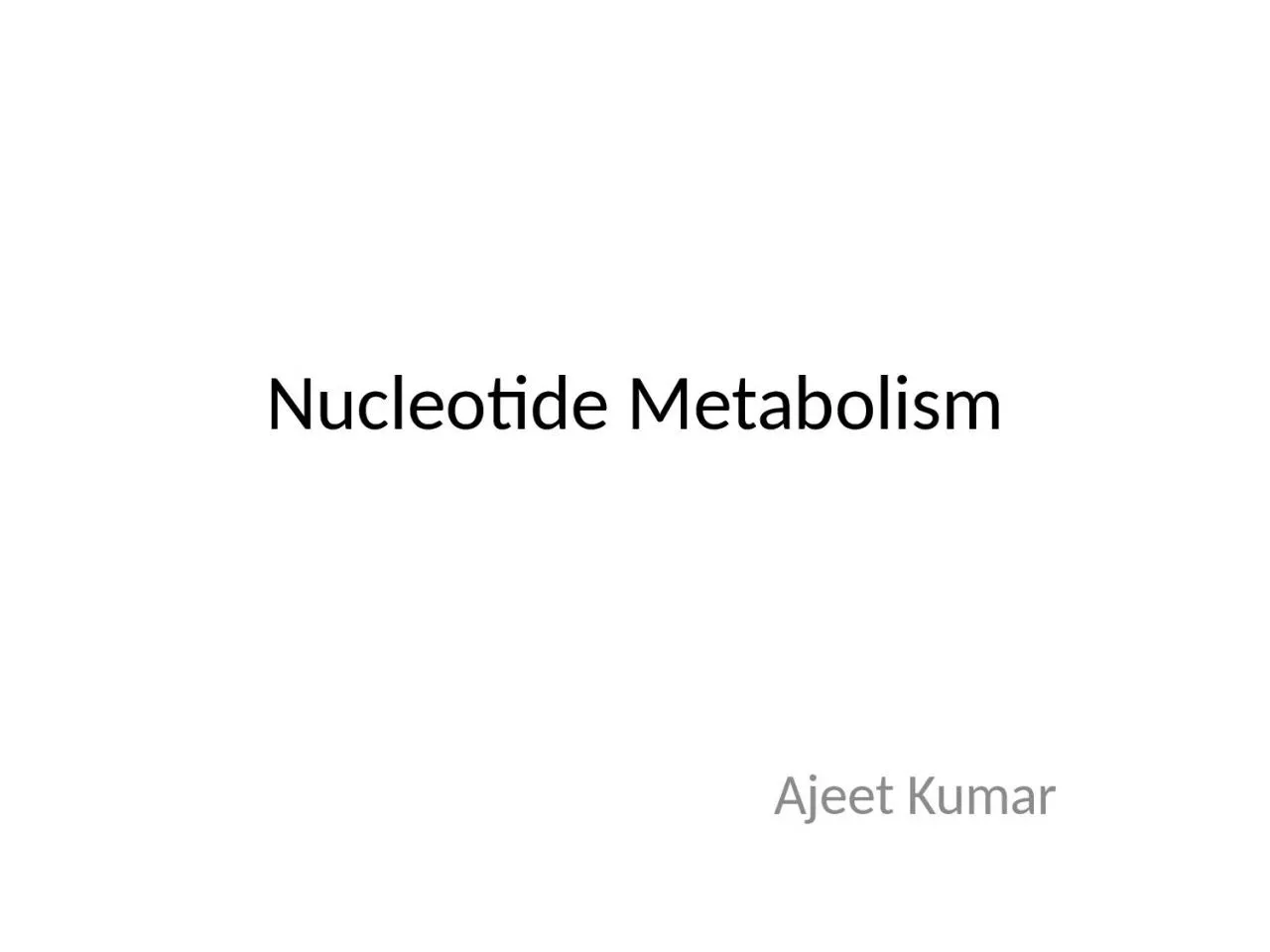

Kumar Nucleotide Metabolism PURINE RIBONUCLEOTIDES formed de novo ie purines are not initially synthesized as free bases First purine derivative formed is Inosine Monophosphate IMP ID: 916253
Download Presentation The PPT/PDF document "Nucleotide Metabolism Ajeet" is the property of its rightful owner. Permission is granted to download and print the materials on this web site for personal, non-commercial use only, and to display it on your personal computer provided you do not modify the materials and that you retain all copyright notices contained in the materials. By downloading content from our website, you accept the terms of this agreement.
Slide1
Nucleotide Metabolism
Ajeet
Kumar
Slide2Nucleotide Metabolism
PURINE RIBONUCLEOTIDES: formed
de novo
i.e., purines are not initially synthesized as free basesFirst purine derivative formed is Inosine Mono-phosphate (IMP)The purine base is hypoxanthineAMP and GMP are formed from IMP
Slide3Purine Nucleotides
Get broken down into Uric Acid (a purine) Buchanan (mid 1900s) showed where purine ring components came from:
N
1: Aspartate AmineC2, C8: Formate
N
3
, N
9
: Glutamine
C
4
, C
5
, N
7
: Glycine
C
6
: Bicarbonate Ion
Slide4Purine Nucleotide Synthesis
Slide5Purine Nucleotide Synthesis
at a Glance
ATP is involved in 6 steps
PRPP in the first step of Purine synthesis is also a precursor for Pyrimidine Synthesis, His and Trp synthesisRole of ATP in first step is unique– group transfer rather than couplingIn second step, C1
notation changes from a
to
b
(anomers specifying OH positioning on C
1
with respect to C
4
group)
In step 2, PP
i
is hydrolyzed to 2P
i
(irreversible, “committing” step)
Slide6Regulatory Control of Purine Nucleotide Biosynthesis
GTP is involved in AMP synthesis and ATP is involved in GMP synthesis (reciprocal control of production)
PRPP is a biosynthetically “central” molecule (why?)
ADP/GDP levels – negative feedback on Ribose Phosphate Pyrophosphokinase Amidophosphoribosyl transferase is activated by PRPP levelsAPRT activity has negative feedback at two sitesATP, ADP, AMP bound at one siteGTP,GDP AND GMP bound at the other siteRate of AMP production increases with increasing concentrations of GTP; rate of GMP production increases with increasing concentrations of ATP
Slide7Purine Catabolism and Salvage
All purine degradation leads to
uric acid
(but it might not stop there)Ingested nucleic acids are degraded to nucleotides by pancreatic nucleases, and intestinal phosphodiesterases in the intestineGroup-specific nucleotidases and non-specific phosphatases degrade nucleotides into nucleosidesDirect absorption of nucleosides Further degradation Nucleoside + H
2O
base + ribose (nucleosidase)
Nucleoside + P
i
base + r-1-phosphate (n. phosphorylase)
NOTE: MOST INGESTED NUCLEIC ACIDS ARE DEGRADED AND EXCRETED.
Slide8Intracellular Purine Catabolism
Nucleotides broken into nucleosides by action of 5’-nucleotidase (hydrolysis reactions)
Purine nucleoside phosphorylase (PNP)
Inosine HypoxanthineXanthosine XanthineGuanosine Guanine
Ribose-1-phosphate splits off
Can be isomerized to ribose-5-phosphate
Adenosine is deaminated to Inosine (ADA)
Slide9Intracellular Purine Catabolism
Xanthine is the point of convergence for the metabolism of the purine bases
Xanthine
Uric acidXanthine oxidase catalyzes two reactionsPurine ribonucleotide degradation pathway is same for purine deoxyribonucleotides
Slide10Adenosine Degradation
Slide11Xanthosine Degradation
Ribose sugar gets recycled (Ribose-1-Phosphate
R-5-P )
– can be incorporated into PRPP (efficiency) Hypoxanthine is converted to Xanthine by Xanthine Oxidase Guanine is converted to Xanthine by Guanine Deaminase Xanthine gets converted to
Uric Acid by
Xanthine Oxidase
Slide12Xanthine Oxidase
A homodimeric protein
Contains electron transfer proteins
FADMo-pterin complex in +4 or +6 state Two 2Fe-2S clustersTransfers electrons to O2 H2
O
2
H
2
O
2
is toxic
Disproportionated to H
2
O and O
2
by catalase
Slide13Purine
Salvage
Adenine phosphoribosyl transferase (APRT)
Adenine + PRPP AMP + PPiHypoxanthine-Guanine phosphoribosyl transferase (HGPRT)Hypoxanthine + PRPP IMP + PP
i
Guanine + PRPP GMP + PP
i
(NOTE: THESE ARE ALL
REVERSIBLE
REACTIONS)
AMP,IMP,GMP do not need to be resynthesized
de novo !
Slide14Gout
Impaired excretion or overproduction of uric acid
Uric acid crystals precipitate into joints (Gouty Arthritis), kidneys, ureters (stones)
Lead impairs uric acid excretion – lead poisoning from pewter drinking gobletsFall of Roman Empire?Xanthine oxidase inhibitors inhibit production of uric acid, and treat goutAllopurinol treatment – hypoxanthine analog that binds to Xanthine Oxidase to decrease uric acid production
Slide15Pyrimidine Ribonucleotide Synthesis
Uridine Monophosphate (UMP) is synthesized first
CTP is synthesized from UMP
Pyrimidine ring synthesis completed first; then attached to ribose-5-phosphateN1, C4, C5
, C6
: Aspartate
C
2
: HCO
3
-
N
3
: Glutamine amide Nitrogen
Slide16Pyrimidine Synthesis
Slide17UMP Synthesis Overview
2 ATPs needed: both used in first step
One transfers phosphate, the other is hydrolyzed to ADP and Pi
2 condensation rxns: form carbamoyl aspartate and dihydroorotate (intramolecular)Dihydroorotate dehydrogenase is an intra-mitochondrial enzyme; oxidizing power comes from quinone reductionAttachment of base to ribose ring is catalyzed by OPRT; PRPP provides ribose-5-PPPi splits off PRPP – irreversibleChanneling: enzymes 1, 2, and 3 on same chain; 5 and 6 on same chain
Slide18OMP DECARBOXYLASE : THE MOST CATALYTICALLY PROFICIENT ENZYME
FINAL REACTION OF PYRIMIDINE PATHWAY
ANOTHER MECHANISM FOR DECARBOXYLATION
A HIGH ENERGY CARBANION INTERMEDIATE NOT NEEDEDNO COFACTORS NEEDED !SOME OF THE BINDING ENERGY BETWEEN OMP AND THE ACTIVE SITE IS USED TO STABILIZE THE TRANSITION STATE“PREFERENTIAL TRANSITION STATE BINDING”
Slide19Slide20UMP
UTP and CTP
Nucleoside monophosphate kinase catalyzes transfer of Pi to UMP to form UDP; nucleoside diphosphate kinase catalyzes transfer of Pi from ATP to UDP to form UTPCTP formed from UTP via CTP Synthetase driven by ATP hydrolysis Glutamine provides amide nitrogen for C4
in animals
Slide21
Slide22Regulatory Control of Pyrimidine Synthesis
Differs between bacteria and animals
Bacteria – regulation at ATCase rxn
Animals – regulation at carbamoyl phosphate synthetase IIUDP and UTP inhibit enzyme; ATP and PRPP activate itUMP and CMP competitively inhibit OMP Decarboxylase*Purine synthesis inhibited by ADP and GDP at ribose phosphate pyrophosphokinase step, controlling level of PRPP also regulates pyrimidines